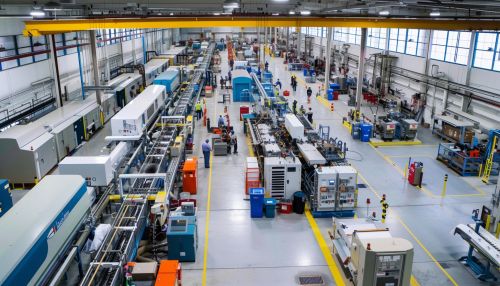Industrial Workplaces
Overview
Industrial workplaces, also known as industrial sites, are physical locations where industrial activities take place. These activities can range from manufacturing and production to warehousing and distribution. Industrial workplaces are characterized by their focus on the production of goods and services, often involving the use of heavy machinery and specialized equipment.
History
The concept of an industrial workplace emerged during the Industrial Revolution, a period of rapid industrial growth that began in the late 18th century. This era saw a shift from small-scale, home-based production to large-scale, factory-based production. The industrial workplace evolved over time, influenced by technological advancements, economic changes, and societal shifts.
Types of Industrial Workplaces
There are several types of industrial workplaces, each with its own unique characteristics and functions.
Manufacturing Plants
Manufacturing plants are facilities where raw materials are transformed into finished goods. These workplaces are often large, complex facilities that require specialized machinery and skilled labor.
Warehouses
Warehouses are large buildings where goods are stored before they are distributed to retailers or customers. They are an essential component of the supply chain, providing storage and distribution services.
Power Plants
Power plants are industrial workplaces that generate electricity. They can be powered by a variety of sources, including coal, natural gas, nuclear energy, or renewable resources like wind and solar power.
Construction Sites
Construction sites are temporary industrial workplaces where buildings or infrastructure are built. These workplaces are characterized by their transient nature, as they exist only for the duration of the construction project.
Safety in Industrial Workplaces
Safety is a critical concern in industrial workplaces. Due to the nature of the work and the machinery involved, these workplaces can pose significant risks to workers. Therefore, safety regulations and procedures are put in place to protect workers and prevent accidents.
Occupational Safety and Health Administration (OSHA)
In the United States, the Occupational Safety and Health Administration (OSHA) is responsible for enforcing safety and health regulations in industrial workplaces. OSHA sets and enforces standards and provides training, outreach, education, and assistance.
Personal Protective Equipment (PPE)
Personal protective equipment (PPE) is used in many industrial workplaces to protect workers from hazards. PPE can include items like helmets, gloves, eye protection, high-visibility clothing, safety footwear, and safety harnesses.
Future of Industrial Workplaces
The future of industrial workplaces is being shaped by several key trends, including automation, digitization, and sustainability.
Automation
Automation is transforming industrial workplaces by replacing manual labor with machines. This can increase efficiency and productivity, but it also raises concerns about job displacement and the need for worker retraining.
Digitization
The digitization of industrial workplaces involves the use of digital technologies to improve processes, enhance productivity, and reduce costs. This includes the use of technologies like the Internet of Things (IoT), Artificial Intelligence (AI), and Big Data.
Sustainability
Sustainability is becoming increasingly important in industrial workplaces. This involves implementing practices that minimize environmental impact, such as reducing energy consumption, minimizing waste, and using renewable resources.


